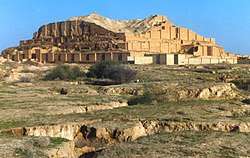Pre-Parsian style
The pre-Parsian style (New Persian:شیوه معماری پیش از پارسی) is a sub-style of architecture (or "zeer-sabk") when categorizing the history of Persian/Iranian architectural development.
This style of architecture flourished in the Iranian Plateau until the eighth century B.C.E. during the era of the Median Empire. It is often classified as a subcategory of Parsian architecture.[1]
The oldest remains of the architectural landmarks in this style are the Teppe Zagheh, near Qazvin. Other extant examples of this style are Chogha zanbil, Sialk, Shahr-i Sokhta, and Ecbatana.
Elamite and proto-Elamite buildings among others, are covered within this stylistic subcategory as well.
Gallery
 Sialk necropolis. 3000-4000 B.C.E.
Sialk necropolis. 3000-4000 B.C.E. Chogha Zanbil ziggurat. 1250 B.C.E.
Chogha Zanbil ziggurat. 1250 B.C.E.
References
See also
This article is issued from
Wikipedia.
The text is licensed under Creative Commons - Attribution - Sharealike.
Additional terms may apply for the media files.
